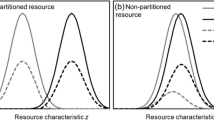Summary
Many animals exploit resources distributed in separate patches. It is commonly assumed that the aim of individuals travelling between patches and exploiting them is to maximize their rate of resource intake, and that the costs of searching for resources are one obvious constraint in fitness maximization. This paper also takes into account some asymmetries between competitors. Conflicts between individuals take the form of either competition by exploitation or of overt contests for resource items. A simple model is developed to answer the question: Which animal should withdraw and when (thereby leaving his opponent within a patch)? It was found that evolutionarily stable strategies (ESS's) are based not only on existing asymmetries but also on current population density. It is possible for conventional and paradoxical ESS's to occur when a patch exists for a sufficiently long period of time in relation to the time of travelling between patches. These strategies can be expected when resources are not overcrowded or when the costs associated with joint exploitation of patches are high. This result is compared with the existing models of animal conflicts for distinct indivisible resources. Some topics concerning optimal foraging and migration decisions are discussed, and empirical evidence is examined.
Similar content being viewed by others
References
Davies NB (1978) Territorial defence in the speckled wood butterfly (Pararge aegeria), the resident always wins. Anim Behav 26:138–147
Davies NB (1979) Game theory and territorial behaviour in speckled wood butterflies. Anim Behav 27:961–962
Davies NB, Halliday TR (1978) Deep croaks and fighting assessment in toads, Bufo bufo. Nature 274:683–685
Davies NB, Halliday TR (1979) Competitive mate searching in common toads, Bufo bufo. Anim Behav 27:1253–1267
Enquist M, Leimar O (1983) Evolution of fighting behaviour: decision rules and assessment of relative strength. J Theor Biol 102:387–410
Fretwell SD (1972) Populations in a Seasonal Environment. Princeton University Press, Princeton
Gardner R, Morris MR, Nelson CE (1987) Conditional evolutionarily stable strategies. Anim Behav 35:507–517
Grafen A (1987) The logic of divisively asymmetric contests: respect for ownership and the desperado effect. Anim Behav 35:462–467
Hammerstein P (1981) The role of asymmetries in animal contests. Anim Behav 29:193–205
Hammerstein P, Parker GA (1982) The asymmetric war of attrition. J Theor Biol 96:647–682
Korona R (1989) Evolutionarily stable strategies in competition for resource intake rate maximization. II. Oviposition behaviour in Tribolium confusum. Behav Ecol Sociobiol
Lomnicki A (1978) Individual differences between animals and natural regulation of their numbers. J Anim Ecol 47:461–475
Lomnicki A (1988) Population Ecology of Individuals. Princeton University Press, Princeton
Maynard Smith J (1974) The theory of games and and the evolution of animal conflicts. J Theor Biol 47:209–221
Maynard Smith J, Parker GA (1976) The logic of asymmetric contests. Anim Behav 24:159–175
Maynard Smith J, Price GR (1973) The logic of animal conflict. Nature 246:15–18
Parker GA, Rubenstein DI (1981) Role assessment reserve strategy, and acquisition of information in asymmetric animal contests. Anim Behav 29:221–240
Selten R (1980) A note on evolutionarily stable strategies in asymmetric animal conflicts. J Theor Biol 84:93–101
Thornhill R (1980) Sexual selection within mating swarms of the lovebug, Plecia nearetica (Diptera: Bibionidae). Anim Behav 28:405–412
Whitham TG (1979) Territoral behaviour of Pemphigus gall aphids. Nature 279:324–325
Whitham TG (1980) The theory of habitat selection: examined and extended using Pemphigus aphids. Am Nat 115:449–466
Whitham TG (1986) Costs and benefits of territoriality: behavioural and reproductive release by competing aphids. Ecology 67:139–147
Wickman P-O, Wiklund C (1983) Territorial defence and its seasonal decline in the speckled wood butterfly (Pararge aegeria). Anim Behav 31:1206–1216
Author information
Authors and Affiliations
Rights and permissions
About this article
Cite this article
Korona, R. Evolutionarily stable strategies in competition for resource intake rate maximization. Behav Ecol Sociobiol 25, 193–199 (1989). https://doi.org/10.1007/BF00302918
Received:
Accepted:
Issue Date:
DOI: https://doi.org/10.1007/BF00302918




